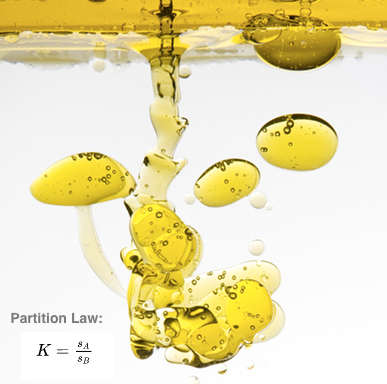Chemistry - Partition Law

Problem Set
What will the scientists do if they want to extract and help purify a desired product from a reaction mixture? This is when the Partition Law(or Distribution Law) saves the day!
First, we set some variables:
Let and be two immiscible liquids(cannot dissolve or react with each other), such as water and oil.
Let the solubility of in liquid be .
Let the solubility of in liquid be .
Now, we do the following steps:
1) Mix solute into the mixture of liquid and .
2) Stir them constantly and wait till liquid and liquid are divided into two layers(they will as they cannot dissolve each other).
3) Now, solute is dissolved in both solvent and solvent but the concentration is different.
This is what Partition Law wants to deliver to us.
Definition: At a fixed temperature, when a solute is added to a system consisting of two solvent, it will distribute itself between the two solvent in proportion to its solubility in each of the two solvent separately.
If we express the definition in formula, it will be
where is the partition coefficient.
If at , the solubility of is water and ether, then the partition coefficient
.
Now there is an example:
If water can dissolve organic compound and I use ether to extract it, what is the mass in grams of are left in the ether layer?
Details:
Solution:
Let the amount extracted be .
The solubility of in water is
The solubility of in ether is
Then,
So, the mass of that left in the ether layer is .
**Note that I use as the unit of solubility instead of in my note before.
Solubility of water means water can dissolve a maximum of of that solute.
Solubility of water means water can dissolve a maximum of of that solute.
So, the unit does not make any changes to the answer as long as we use the same unit. As the example above, we cannot use a unit of solubility written as while the other written as .
Easy Math Editor
This discussion board is a place to discuss our Daily Challenges and the math and science related to those challenges. Explanations are more than just a solution — they should explain the steps and thinking strategies that you used to obtain the solution. Comments should further the discussion of math and science.
When posting on Brilliant:
*italics*or_italics_**bold**or__bold__paragraph 1
paragraph 2
[example link](https://brilliant.org)> This is a quote# I indented these lines # 4 spaces, and now they show # up as a code block. print "hello world"\(...\)or\[...\]to ensure proper formatting.2 \times 32^{34}a_{i-1}\frac{2}{3}\sqrt{2}\sum_{i=1}^3\sin \theta\boxed{123}Comments
Why is x=66.7g?
Log in to reply
21=x100−x
x=200−2x
3x=200
x=66.7
Log in to reply
Oh... Thanks
Thx for the information
Good Post...
good post
nice.. :)
Peter Taylor-
I like the way you added the problems into the notes. However, I don't know how to add a line between the problem and the note. Can you teach me, please?
Log in to reply
To make a line between things use 3 dashes in a row at the beginning of the line. For instance, this is a picture of the markdown on your problem set in the first note.
Log in to reply
Thanks!
I also took the liberty of making you a picture. It's not the best, and it is a little bit of stretch, seeing as the post is mostly about partitioning and not about miscibility. If you don't like it, I can take the picture away.
Log in to reply
The picture is very nice, thanks!
Thanks Christopher for this post which is completely new to me.
Thanks for the post! Never learned this back in secondary school.
What does "extract" mean?
Log in to reply
Literal Definition: to remove/separate a certain substance(useful) from another substance through various Physical and Chemical methods.
To obtain a substance by chemical or mechanical action, as by pressure, distillation, or evaporation. (Google)
Thanks
If 10.0 mg of compound is disolved in 50.0ml of water and this extracted with 25.0 ml of CCL4 . How many mg remain. K=56